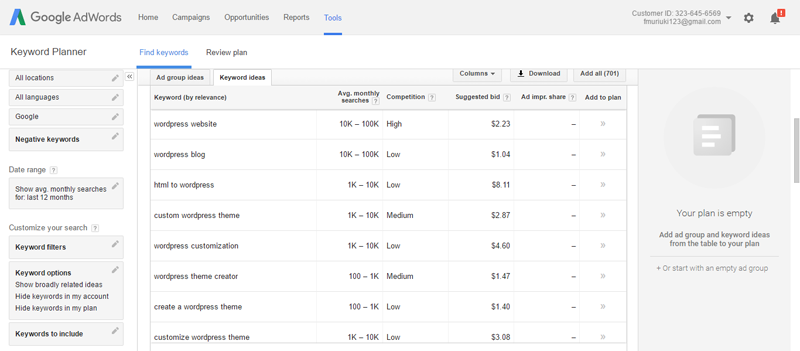Video SEO Tips to Get the Most from WordPress Videos

Let’s talk about video SEO, the impact videos have on user experience and search rankings, and how you can optimize your videos to get the most SEO juice.
Quickly, I will drop a couple of video marketing stats to – you know – build some momentum. Did you know:
- A third of all online activity is spent watching video?
- 90% of users say that product videos are helpful in the decision making process?
- Enjoyment of video ads increase purchase intent by 97% and brand association by 139%
- Including a video on a landing page can increase conversion by 80%?
- Articles with videos get three times more links than plain text articles?
Ins and Outs of Video SEO
While these stats are impressive, what does this have to do with video SEO? Well, SEO (or search engine optimization to the uninitiated), is just one among the many pieces of the digital marketing puzzle. The other and most important piece is getting the traffic you attract to actually convert.
Videos can help you to bridge the gap between search engine traffic and conversion. In other words, videos have a huge positive impact on your search rankings and conversion rates.
Video is no longer an “up-and-coming” marketing tactic – it’s here, and it’s a powerful way to communicate your brand story, explain your value proposition, and build relationships with your customers and prospects. – Lindsay Kolowich
In the not-so distant past, we outlined a couple of WordPress SEO tips in a number of posts including the Best WordPress SEO Tools and WordPress SEO Best Practices.
The key takeaway from the above posts is SEO extends far beyond plain text SEO. You should optimize your text, images, videos and take care of other technical SEO details to get the most out of your SEO efforts. But let’s not lose ourselves here, we shall focus on video SEO and only that for the remainder of this post.
How to Get the Most Out of Video SEO
Now, let’s delve deeper into video SEO and look at the steps you should take to get the most SEO out of your WordPress videos (through really these tips apply to any video).
Video SEO Keywords
Search engine optimization begins with keyword research that’s a no brainer. If you sell WordPress themes, for instance, you obviously want to rank highly for the term “WordPress themes”, “premium WordPress themes” and other related terms. This also applies to video SEO.
Nowadays, Google enriches search results using rich media such as videos with more than 90% of said videos coming from YouTube (also owned by Google). Studies by MarketingLand and Searchmetrics show that over 50% of Google universal searches include videos. This means a huge chunk of searchers are exposed to a YouTube video at any given time.
Video publishers such as YouTube among others are huge traffic sources especially when you consider:
- Video search results have a 41% higher click-through rates than plain text results (Source aimClear) and
- Videos are 50 times more likely to get organic Google page ranks than plain text results (Forrester Research)
But it all begins with astute video SEO keyword research. You are to focus on niche-specific keywords that have video results on the first page of Google.
Aside: Google has a soft spot for how-to videos, reviews, tutorials and funny videos. Videos with titles such as “How to Setup WordPress”, “Create WordPress theme”, “Setting up WordPress theme” and funny videos such as “funny cats” will score amazing spots in Google search results.
If you optimize your video around keywords that have video results on the first page of Google, and host the video on YouTube, you will get targeted traffic both from Google and YouTube. And if you didn’t know, YouTube is the second-largest search engine.
How to Find Video SEO Keywords
But how do you get video SEO keywords relevant to your niche? It’s simple. If you’re in the WordPress theme niche, for example, you will look for video SEO keywords using searches like “create a WordPress theme”, “WordPress theme tutorial” and so on.
To put my money where my mouth is, I gave this a test drive and searched “Create a WordPress theme” on Google. The keyword brings up a YouTube result in Google. Not bad:

Armed with a video SEO keyword, all you have to do is check whether there’s adequate search volume for that keyword. Here, feel free to use the Google Keyword Planner tool (free).
According to Brian Dean of Backlinko, ensure your keyword gets at least 300 monthly searches. From our Google Keyword Planner, we see that “create WordPress theme” gets an average of between 1k and 10k monthly searches. This is really good:

Bonus: From this very dashboard, we get related keyword ideas, and the average monthly searches as well as the level competition for each related keyword:

Why is this important? More keyword ideas mean more ideas for your videos and other content. As long as a keyword has more than 300 monthly searches, it’s a great keyword to create a video around. The more the searches, the better, just ensure the competition for that specific keyword is low to medium.
If you create a video around your keyword and get it to rank well in Google, you’re golden as far as video SEO goes.
Now that you have a keyword (and related keywords), it’s time to create your video(s).
Create Awesome Videos
Just like plain text content, the more you put into your video, the more you will get out of it. Shoddy work won’t get you anywhere. Remember poor content doesn’t rank in this time and era, so don’t expect your video to rank if it’s uninteresting, unoriginal, irrelevant and/or doesn’t provide any value at all.
Creating a high quality video costs less than $200 bucks even if you hire a videographer and a graphics editor. If you’re operating on a shoestring budget, you can bootstrap and use many of the screen recording tools available (we like Screencast-O-Matic).
Really, you don’t have to hire actors for your videos. Animation is quite popular and photo montages can help you tell a story especially if you throw some parallax magic into the mix, but many times providing helpful and direct content is all you need to focus on.
Provide value, make your video interesting/funny and remain relevant to your target audience to boost user engagement, which is the most important ranking signal for YouTube videos.
More Views = Better Video SEO
If more people keep watching, subscribing, commenting, liking and sharing your videos, you will keep rising up the ranks on Google. If your video sucks, it won’t rank no matter how much SEO you throw behind it.
Great videos provide amazing results for video SEO, link building and brand awareness. Case in point is the Dollar Shave Club video that went viral a while ago, and now earns the business (dollarshaveclub.com) tens of thousands of links (some from huge sites such as Mashable, Forbes, BusinessWeek, The Next Web etc.), a lot of brand exposure and other recurring SEO benefits to this very day.
Said video has over 23 million views, and in July 2016, Unilever bought Dollar Shave Club for one billion dollars. Cha-ching!
On matters of video length, I wouldn’t worry myself one bit. Some SEO experts argue shorter videos are better than longer ones and vice versa, and I say let them argue. As long as your video is awesome, people will watch it no matter the duration. I know, I watch video gameplays back to back and most are more than one hour long. Hundreds of thousands of other people watch these videos too, so make it two hours long or two minutes long – it doesn’t matter.
Optimize Your Video SEO
You can choose to upload videos to your domain but I advocate uploading to YouTube. Allow me to expound. Below is a graph that shows the most frequent video snippet domains. In layman’s language, it shows which sites Google gives preference as far as video results in SERPs (search engine results pages) go.

From the above chart, where would you like to host your videos? YouTube or your own domain? I vote YouTube any day, because numbers do not lie.
Secondly, and we mentioned this earlier, YouTube is the second-largest search engine owned by Google. Are people more likely to find your videos on your domain or on YouTube? You don’t have to answer. Google want more and more business, and the more people they can get to YouTube videos, the higher the profit margin.
Thirdly, you can create backlinks from YouTube – one in your channel profile, and one in each video description you write thereafter. Never has a backlink been a bad thing, especially if it’s from the second-largest search engine. Exposure on YouTube that triggers secondary action (read people clicking through to your web properties) is best for small and big businesses in an era dominated by Google this and Google that.
Last but not least, you save your site (and your server) the extra load, which culminates in faster page load speeds, hence better SEO scores. After all, YouTube videos are easy to embed and compatible with most if not all browsers. Other people can also embed your videos easily earning you inbound links and consecutively more traffic.
The Nuts & Bolts of Video SEO

So, how do you optimize videos for SEO? That’s the big question, right?
Make Your Videos Light
When uploading your videos, obviously upload the highest quality that you can. While many vloggers may be headed to the 4k realm, there’s no need to go that far when uploading WordPress tutorials and guides. Record videos in 720p (if possible) with a 16:9 aspect ratio to ensure optimal viewing.
But when embedding your videos use a light touch. Google emphasizes on page load speeds as a ranking metric, so you better use whichever tools and techniques at your disposal to ensure your videos don’t bog down your site. You can even use video thumbnails that will load the player only when the user triggers the play button. Do what you can to optimize embedded videos so they load fast.
This is great for user experience as well, especially with the exponential rise of mobile users who leave your site after four seconds of waiting. Nobody has time for a site that takes an age and a round trip to the sun to load.
Label Your Videos Appropriately
See how you sprinkle keywords throughout your text content? You need to provide more information to search spiders so they can identify and index your videos. Include your SEO keywords in your video filenames, titles, tags and descriptions to ensure you rank for context and relevancy.
Also, when uploading your videos choose a thumbnail that makes sense. Until your YouTube channel is verified you’ll have to settle for a frame from your video, but after verification you can upload custom thumbnails with added text or overlays to better describe
Add Video Transcripts and Sitemaps
Using our “WordPress themes” example again, if you create a video revolving around WordPress themes, you will obviously mention “WordPress themes” somewhere in there. Search engine crawlers don’t “see” your videos like human beings do, which brings us to transcripts and sitemaps.
A transcript of the audio portion of your video offers you more real estate to include your keywords, which improves find-ability. Transcripts also offer your users the option of “reading” your video if they can’t listen at any given time. Additionally, you can even use a specific transcript as a base for a post that links to your other content. When all is said and done, transcripts allow you to unlock the textual content in your videos – the content that search engines understand.
Video sitemaps are an extension of your content sitemap, which help search engines find and index your videos alongside your other content. Best part is you can customize video sitemaps to include metadata, which boosts the relevance of your videos to search requests. Yoast offers a great Video SEO plugin just for this purpose.
Make Your Videos Easy to Find
First off, take advantage of the description box and tags when upload a video to YouTube. Be sure to use keywords and include relevant links to your website where viewers can find more information on the topic you’re covering. Add relevant tags so your video is easy to find for YouTube users and search engines.
From a find-ability and user experience point of view, you also need to make your embedded videos easy to find on your website. Embed one video per post/page and follow that up with relevant categories and tags. This makes it easy for users and search engines to find your videos.
Add Interactive Elements Your Videos
While shares, likes and favorites are good indicators that you’re doing something right, they don’t necessarily mean you will strike your SEO goals. You can capture viewers at key moments in your videos. I’m talking about interactive elements such as in-video forms, links and quizzes that guide your viewers to the next logical step long before the video ends.
Share Your Videos for More Video SEO Juice
It’s not enough to create videos; that’s just the first and easiest part of the equation. People need to view your videos because 1) it makes you feel great and 2) more views mean better rankings. So don’t be ashamed to promote your video vigorously, or just as much as you promote your blog posts.
Share your videos on social media because social signals mean something to Google. It’s an indicator of relevance and value since the more you have, the better your video ranks. In one line, promote your videos everywhere.
Final Words
Google continues to attach more importance to videos as far as ranking goes. On top of that, online video consumption keeps growing as more consumers like, use and remember video. As a matter of fact, YouTube reports mobile video consumption rises 100% every year. [Source: Hubspot]
Moreover, video has become more accessible and affordable for small businesses. Which begs the question: Why haven’t you implemented Video SEO yet?
Have a question or suggestion? We are listening. Drop us a line in the comments below and we will get back to you in no time. Thanks in advance!




I am truly delighted to glance at this blog posts which includes plenty
of valuable information, thanks for providing such information.
Hi there! Thanks for the topic with a lot of various and meaningful discussions. It is very important in our day to day life as a marketer. Cheers!
Focus on the basics first but make sure to keep improving your video content and don’t forget to optimize it.